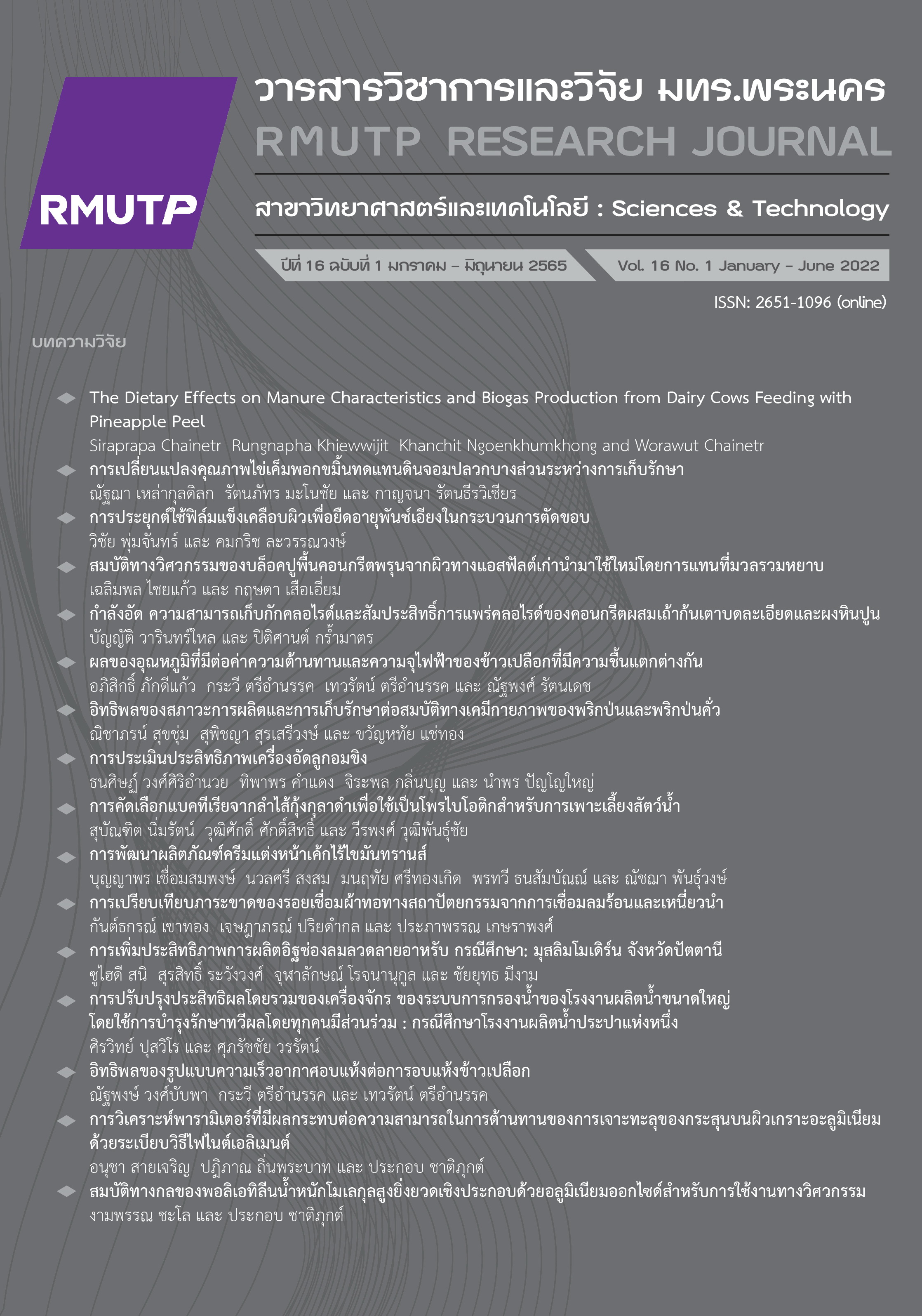Mechanical Properties of UHMWPE Composite with Al2O3 for Application in Engineering
Main Article Content
Abstract
In conducting the research on Material Science, two composite materials, ultra high molecular weight polyethylene (UHMWPE) powder and aluminum oxide (Al2O3) powder were formulated by hot compression molding process. The formulated materials demonstrated good mechanical properties. Based on the studies, the Al2O3 grade selected was Al2O3 HTM 30 harboring mixed uneven powder particle sizes ranging from 2 to 5 microns (µm) and selected proportion of Al2O3 alloy mixed for improving mechanical and wear resistance properties of the UHMWPE composite material was the UHMWPE+Al2O3 HTM 30 at a ratio of 95:5%. When considering both material properties and cost effectiveness in the impact test, 2-5 µm Al2O3 HTM carried the higher impact strength than other aluminum oxide grades with the values up to 586.8 J/m at a ratio of 5% aluminum oxide. The hardness test of the 2-5 µm UHMWPE+ Al2O3 HTM delivered the hardness at 58.8 using the standard durometer. The tensile test values consisted of yield strength, ultimate tensile strength, elongation at break, and modulus of elasticity equal to 20.52 MPa, 29.96 MPa, 265.80% and 784.46 MPa, respectively.
Article Details

This work is licensed under a Creative Commons Attribution-NonCommercial-NoDerivatives 4.0 International License.
ลิขสิทธ์ ของมหาวิทยาลัยเทคโนโลยีราชมงคลพระนครReferences
O. Hussain, B. Ahmad and S. Saleem, “Tribological performance of biomedical grade UHMWPE/nano-Al2O3/Vitamin-C hybrid composite for cartilage replacements,” Mater. Lett., vol. 291, p. 129515, May 2021.
F. S. Senatov et al., “Biocompatible polymer composites based on ultrahigh molecular weight polyethylene perspective for cartilage defects replacement,” J. Alloys Compd., vol. 586, pp. S544–S547, Feb. 2014.
N. N. Mallikarjuna, A. Venkataraman and T. M. Aminabhavi, “A study on γ-Fe2O3 loaded poly (methyl methacrylate) nanocomposites,” J. Appl. Polym. Sci., vol. 94, no. 6, pp. 2551–2554, 2004.
S. M. Kurtz. UHMWPE Biomaterials Handbook, Elsevier Ins., China, 2009.
M. Hussain et al., “Ultra-High-Molecular-Weight-Polyethylene (UHMWPE) as a Promising Polymer Material for Biomedical Applications: A Concise Review,” Polymers, vol. 12, no. 2, p. 323, Feb. 2020.
Z. Tai, Y. Chen, Y. An, X. Yan, and Q. Xue, “Tribological Behavior of UHMWPE Reinforced with Graphene Oxide Nanosheets,” Tribol. Lett., vol. 46, no. 1, pp. 55–63, Apr. 2012.
S. Gürgen, O. N. Çelik and M. C. Kuşhan, “Tribological behavior of UHMWPE matrix composites reinforced with PTFE particles and aramid fibers,” Compos. Part B Eng., vol. 173, p. 106949, Sep. 2019.
A. V. Maksimkin, S. D. Kaloshkin, V. V. Tcherdyntsev, F. S. Senatov and V. D. Danilov, “Structure and properties of ultra-high molecular weight polyethylene filled with disperse hydroxyapatite,” Inorg. Mater. Appl. Res., vol. 3, no. 4, pp. 288–295, 2012.
A. V. Maksimkin et al., “Ultra-high molecular weight polyethylene reinforced with multi-walled carbon nanotubes: Fabrication method and properties,” J. Alloys Compd., vol. 536, pp. S538–S540, Sep. 2012.
F. S. Senatov, A. A. Baranov, D. S. Muratov, M. V. Gorshenkov, S. D. Kaloshkin and V. V. Tcherdyntsev, “Microstructure and properties of composite materials based on UHMWPE after mechanical activation,” J. Alloys Compd., vol. 615, pp. S573–S577, Dec. 2014.
J. J. Wu, C. P. Buckley and J. J. O’Connor, “Mechanical integrity of compression-moulded ultra-high molecular weight polyethylene: effects of varying process conditions,” Biomaterials, vol. 23, no. 17, pp. 3773–3783, Sep. 2002.
POLIMAXX, Safety data sheet, (2017 May), IRPC Public Company Limited, Bangkok.
Alumina, alpha Al2O3, 99.5%, Matweb Material property data, [Online]. Available: https://www.matweb.com/search/datasheet.aspx?matguid=0654701067d147e88e8a38c646dda195&n=1&ckck=1
N. K. Myshkin and A. V. Kovalev, “Adhesion and Friction of Polymers, in Polymer Tribology, editors: Sujeet K Sinha and Brian J Briscoe, Imperial College Press, 2009, pp. 3–32.


